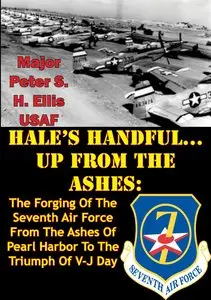Hales Handful… Up from the Ashes: The Forging Of The Seventh Air Force From The Ashes Of Pearl Harbor To The Triumph Of V-J Day by Major Peter S. H. Ellis USAF
English | Feb 17, 2015 | ASIN: B00TQXRMX0 | 139 Pages | PDF (Converted) | 1.46 MB
English | Feb 17, 2015 | ASIN: B00TQXRMX0 | 139 Pages | PDF (Converted) | 1.46 MB
This study analyzes the evolution of Seventh Air Force’s joint command and control relationships as well as the development of joint operational procedures and doctrine in the Central Pacific during World War II. As this was arguably the most “joint” theater in World War II, there are many lessons about the challenges of joint command and control and the development of joint combat procedures that are relevant to contemporary airmen.
The Seventh Air Force was established in the aftermath of the attack on Pearl Harbor. It was initially a defensive and training oriented command—protecting Hawaii from a possible attack by the Japanese and training replacement crews for units in the South Pacific. However, in the summer of 1943, the Seventh Air Force became an offensive, mobile combat command that, along with each of the other services, played a major role in the island-hopping campaign of World War II. Major General Willis H. Hale served as the commander of the Seventh Air Force during this transition period. This study uses him as a lens to explore the unique challenges his command met and overcame. Additionally, since the Pacific Theater was on the tail end of the “Europe First” resupply policy, the Seventh Air Force was chronically under-manned and under-equipped—hence the moniker “Hale’s Handful.”
This study asks three questions in examining the development of joint command and control and operational procedures in the Central Pacific. The first question is to what extent did personalities drive the evolution of command and control relationships, and did they have an effect on the effectiveness of combat operations? This question takes on significance as this work explores General Hale’s rather stormy relationship with his naval superior, Vice Admiral John H. Hoover. Along similar lines, the second question is to what extent did service cultures affect command and control and the development of joint doctrine. Finally, this thesis asks to what extent did this theater’s unique geographic challenges affect interservice friction and the effectiveness of combat operations?
Despite harsh lessons and early setbacks such as the costly victory at Tarawa, by the end of the war the three services’ air forces developed a level of interoperability and shared doctrine that we do not have today. Additionally, this study found that interdiction and CAS were every bit as important as strategic bombing to the success of the island-hopping campaign. While the Central Pacific in World War II is not the only time US forces have had to relearn the importance of CAS, this example stands as a model of inter-service airpower that can be useful to airmen today.



